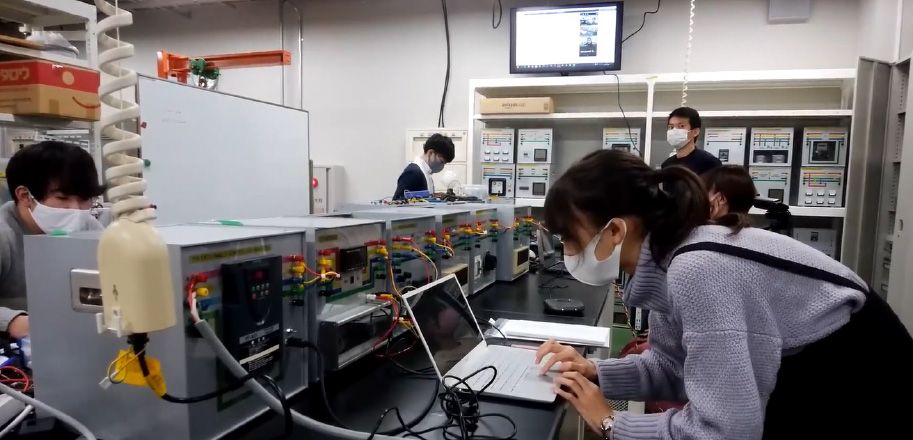Shibaura Institute of Technology Develops Global Project-Based Learning Course on Power Systems Control Using MATLAB, Simulink, and Arduino Hardware
“Our objective is to help engineering students learn to solve industry problems through international collaboration and experimentation. Within our power system laboratory, MATLAB and Simulink make this experimentation possible across multiple universities.”
Challenge
Use a global project-based learning approach to teach undergraduate engineering students basic power systems control theory
Solution
Use MATLAB and Simulink to enable students to collaboratively simulate control designs before running hands-on experiments using an Arduino and real synchronous generator
Results
- Student skills enhanced
- International collaboration enabled
- Ramp-up time minimized

Students at Shibaura Institute of Technology use MATLAB and Simulink to design, implement, and optimize a controller for a synchronous generator.
The global project-based learning (gPBL) program at Shibaura Institute of Technology (SIT) provides an opportunity for students from Japan and overseas partner universities to develop collaboration, systems thinking, and systems management skills as they solve industry problems. In the engineering department, teams of second- and third-year students from Japan, Indonesia, Malaysia, Thailand, and Vietnam work together to design, implement, and optimize a controller for a synchronous generator.
In the past, the course was taught entirely in person, with students traveling from other universities to SIT. Recently, the course transitioned to an online format, in which students use MATLAB® and Simulink® to simulate designs before testing and optimizing them on real hardware via an Arduino® interface.
“The goal of the gPBL course is to introduce students to international collaboration through projects,” says Professor Goro Fujita, who is the course’s lead instructor. “MATLAB and Simulink serve as a meeting point for this collaboration as students learn to design generator controls via modeling, simulation, and experimentation.”
Challenge
When the course transitioned from in-person to online, Professor Fujita and his colleagues needed to redesign the course’s core experiment from scratch. In this redesign, the instructors had to account for a diverse group of engineering students representing a variety of languages, backgrounds, and skillsets.
Throughout the course, Professor Fujita sought to keep the students focused on control design rather than learning and configuring new software. So, he needed tools for modeling and simulation that the students were either already familiar with or could learn quickly. Further, the tools had to integrate easily with the Arduino-based hardware development kit that he and his fellow instructors had built. Lastly, the tools had to facilitate both independent and collaborative project-based learning in an online environment.
Solution
Professor Fujita and his colleagues, including Dr. Sitompul, the course TA, used MATLAB and Simulink to teach student teams from five countries synchronous generator control design as part of the gPBL program at SIT.
In the first part of the course, the professors had the students complete simple exercises in MATLAB and Simulink using the Arduino platform. These exercises, which included making an LED blink or controlling a DC motor, ensured that all students understood the basics of working with MATLAB and Simulink to control hardware via an Arduino interface.
Next, the students began working with the synchronous generator model kit that the instructors created for the course. This kit includes an induction motor, which serves as the prime mover for the synchronous generator. The generator is connected to a transmission line and load.
With guidance from Professor Fujita, the student teams developed a controller model using Simulink and Control System Toolbox™. They then ran closed-loop simulations with their controller model and a plant model of the synchronous generator that Professor Fujita created using Simulink and Simscape™.
In a series of weekly meetings, the students planned and discussed the experiments they would perform, with SIT students performing the hands-on work, and students at the partner universities focused primarily on analysis and simulation.
In one experiment, the SIT students ran an initial version of the controller using Simulink, Simulink Support Package for Arduino Hardware, and the Arduino platform. They then altered the load on the generator and recorded the resulting deviations in voltage and frequency. The overseas students analyzed the results in MATLAB, visualizing them via Bode plots and modeling them via a transfer function.
Based on their analysis, the overseas students adjusted control parameter values in the Simulink model that regulate voltage and frequency through the generator’s induction motor and exciter. The SIT students reran the experiment to measure the effect of these changes on system performance and determine if further optimizations were needed.
Finally, the students compared their simulations with the results from their physical experiments to verify their findings.
Looking beyond synchronous generator control systems, Professor Fujita and his colleagues are currently developing a second laboratory module that will use MATLAB, Simulink, and the Arduino platform for power systems control.
Results
- Student skills enhanced. “MATLAB and Simulink are ideal for students to learn power system control,” says Professor Fujita. “Students can update control parameters in Simulink and then observe the effects on system performance by running experiments via the Arduino connection to the physical generator.”
- International collaboration enabled. “MATLAB and Simulink helped our students learn international collaboration and solve project-level issues using a common language,” Professor Fujita says. “With MATLAB and Simulink, miscommunication problems were minimized.”
- Ramp-up time minimized. “MATLAB and Simulink are important to us in teaching this course, in part because they are so widely used in engineering departments across many universities,” Professor Fujita says. “Because our students already had some knowledge of the software, it was easier for us to introduce our specific experiment module into course.”